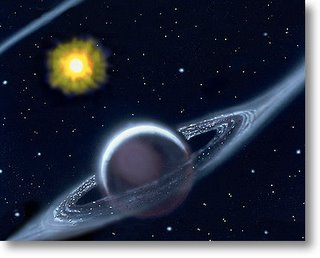 Life's ingredients circle Sun-like star
Life's ingredients circle Sun-like star
From New Scientist 22 December 2005
The first evidence that some of the basic organic building blocks of life can exist in an Earth-like orbit around a young Sun-like star has been provided by NASA's Spitzer Space Telescope. Spitzer took infrared spectrograms of 100 very young stars in a nearby stellar nursery, a huge cloud of dust and gas 375 light years away in the constellation Ophiuchus. And one of those stars showed signs of the organic molecules, acetylene and hydrogen cyanide. These gases, when combined with water, can form several different amino acids. These are needed to form proteins, as well as one of the four chemical letters, or bases, in DNA, called adenine.
The organic molecules were detected in a ring of dust and gas circling a young star called IRS 46. Such dust rings, found around all of the young stars that were examined by the Spitzer telescope, are believed to be the raw material for planetary systems. The spectrographic data showed that the gases were so hot that they must be orbiting close to the star, approximately in its "habitable zone", the region where Earth orbits the Sun and where water is just at the borderline between liquid and gaseous states.
The detection supports the widely held theory that many of the molecular building blocks of life were present in the solar system even before planets formed, thus assisting the initial formation of complex organic molecules and the start of life itself. Observations earlier in 2005 by a different team using Spitzer showed that simpler organic molecules, called polycyclic aromatic hydrocarbons, were present in galaxies as much as 10 billion years ago. The star IRS 46 and its emerging planetary system "might look a lot like ours did billions of years ago, before life arose on Earth", said Fred Lahuis of Leiden Observatory in the Netherlands, who led the research team. Acetylene and hydrogen cyanide have been detected before in places closer to home, such as the atmospheres of the giant planets Jupiter and Saturn, and in comets. Observations by the European Infrared Space Observatory have also shown the compounds to exist around massive stars.
From this and other observations it looks like many of the basic building blocks of life occur spontaneously even before planets themselves form. It’s hardly surprising then that life emerged on Earth so quickly after it cooled about 4 Billion years ago. Likewise it’s not unreasonable to suppose that planets orbiting other stars also had these building blocks which allowed life to emerge there too. I wouldn’t be in the least surprised if our Galaxy and the rest of the Universe where teaming with life – all because of natural processes.

2 comments:
Wow! Fascinating. So the materials are there, but who put them there? How did any of the universes come to be? It would be fascinating to have a movie that speeds up the formation of life to see what types of life forms will evolve and what they will be like. It would be interesting to see if any of the other planets with life on them also believe in some sort of higher force creating them. Is this really happening "spontaneously" or are we watching the hand of God at work, but are failing to actually see God? What if all the universes run on "natural" laws, but like any machine, they need someone/something to start them in motion? Whether energy to start the chain reaction, or some other impetus to "be." I love thinking of all the possibilities. Thanks for sharing!
A pleasure.
Naturally, being an atheist, I don't regard this as "seeing the hand of God at work" but rather as an example of natural processes being played out before our eyes. The planets forming around IRS46 are examples of what probably happened around our Sun 5 or so Billion years ago. Personally I don't need to add God into the mix to find the whole thing fascinating and awe inspiring.
I promise postings on Origins later.... Don't touch that dial...
Post a Comment